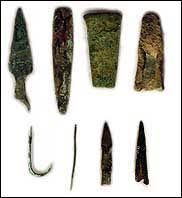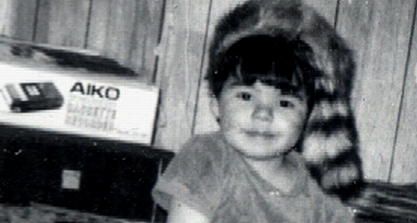I had known that copper had been mined for thousands of years, in the Lake Superior basin, but this article documents a much more extensive archaeological record on the south shores of the Lake, than I had realised. It's a little long, but a good read. The article was written in 1865, however and delivers some expected prejudice.
Here are some excerpts:
{No kidding. :Eric.}
In the month of March, 1848, Samuel O. Knapp and J. B. Townsend discovered, from tracks in the snow, that a hedgehog had taken up his winter-quarters in a cavity of a ledge of rocks, about twelve miles from Ontonagon, Lake Superior, in the neighborhood of the Minnesota Copper Mine. In order to capture their game, they procured a pick and shovel, and commenced an excavation by removing the vegetable mould and rubbish that had accumulated about the mouth of what proved to be a small cavern in the rock. At the depth of a few feet they discovered numerous stone hammers or mauls; and they saw that the cavern was not a natural one, but had been worked out by human agency, and that the stone implements, found in great profusion in and about it, were the tools used in making the excavation. Further examination developed a well-defined vein of native copper running through the rock; and it was evidently with a view of getting this metal that this extensive opening had been made.
At the Hilton Mine in the Ontonagon district, in October, 1863, as the men were removing the vegetable mould that had accumulated in one of the old pits, they found at the depth of about nine feet a leather bag, which was eleven inches long and seven inches wide. It was lying upon a mass of native copper which the ancient miners had unsuccessfully attempted to remove from its parent vein. The bag was in a remarkable state of preservation... - the day after it was discovered, -- it was in the possession of C. M. Sanderson, Esq., the agent of the Knowlton Mine; but I hear it has since been taken to Boston and sold.
In removing the accumulated leaves and vegetable mould, the workmen, at the depth of eighteen feet, discovered a mass of copper ten feet long, three feet wide, and more than a foot thick, weighing six tons...
This mass of copper, like all others found in those ancient pits, was divested of all its ragged points, and hammered perfectly smooth.
{OK; here it comes.}
Many who have been taught to regard the present roving tribes of Indians as instinctively wise in matters of medicine and mining are ready to award to that race the credit of having worked these mines; but, inasmuch as even a traditional knowledge of their existence was unknown to the Indians at the time the Jesuit missionaries visited that region in the sixteenth century, we incline to the opinion that another and distinct race worked them. I am unable to see why the descendants of a people residing in the same country, and subject to the same wants, should abandon the half-worked mines which their ancestors had opened, and even fail to hand down to their posterity a tradition of their existence. If copper was in such demand that the ancestors of the present race of Chippeways were induced to work so perseveringly to obtain it, why did not the children continue to work, at least enough to finish the jobs already commenced by their progenitors? We cannot consistently attribute the Herculean labor expended on these mines to the ancestors of the indolent race of North American Indians. We incline, rather, to the opinion that the miners were the mound-builders, who resided south of the mines, and ultimately found a home in Mexico.
Leave it to the European mindset of the time to see an unused resource as just another reason to disparage the locals. But, he does have a valid question; why were the mines abandoned and unused by the Native peoples of that time and place?
1- The "Chippeways" are also known as Ojibwa, Ojibway and Chippewa; We call ourselves Ahnishnahbeh. According to our legends, we came from the East coast of Canada and the United States, migrating inland, up the Great Lakes. (Probably kicking butt and taking names, all the way.) Certainly, there was also some pressure from the East, when the Europeans starting moving into the interior. The point being, that the mines' locations were not in the 'oral history' of the Chippewa; unless recently rediscovered.
2- Archaeological evidence for copper use, in Northwestern Onatrio actually peaks in the Archaic period, between (approximately) 3 000 - 6 000 years ago. The writer of this article cites a tree-ring (dendrochronology) age of four hundred years for one 'mine', but this represents a 'latest date' for that mine's abandonment, not an earliest. The mines may have been long abandoned, thousands of years before the historic period, with intervening generations of unrelated cultures in between.
3- The Native peoples of the time of the article traded furs and food for gunpowder, iron, sheet copper kettles, glassware, European clay pipes and Brazilian tobacco; etc. Why, bust your hump to pound copper out of the granite?
Anyways; interesting. When I was in the Archaeological department of the Ontario Govt; many moons ago, I was told about a Kenora local guy who brought some copper 'celts' into the office to "get an estimate". Unfortunately, for our looter, Archaeological artifacts are considered public property and the pieces were confiscated. He had been considerate enough to "resharpen" the pieces, before bringing them in; which is kind of like painting a disintegrating Totem Pole. Don't do it.

Tags:
bingorage,
blog,
article review,
copper mine,
metalwork,
archaeology,
News
Digg it!,Add to del.icio.us,
Googlize this post!,Save to newsvine!,Add to RawSugar
Spurl this!,tagtooga This!,Add to MyWeb
Add To Any Service!,Sphere it!


1 comment:
Thanks for sharing this article. The ignorance is a rather sad turn, but the information itself is quite intriguing.
Post a Comment